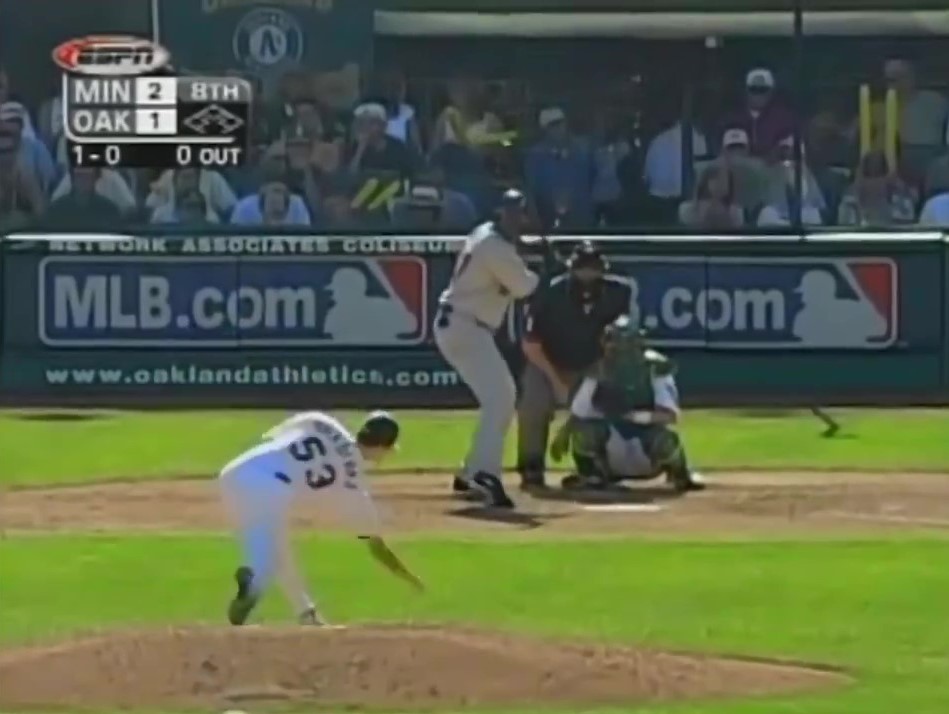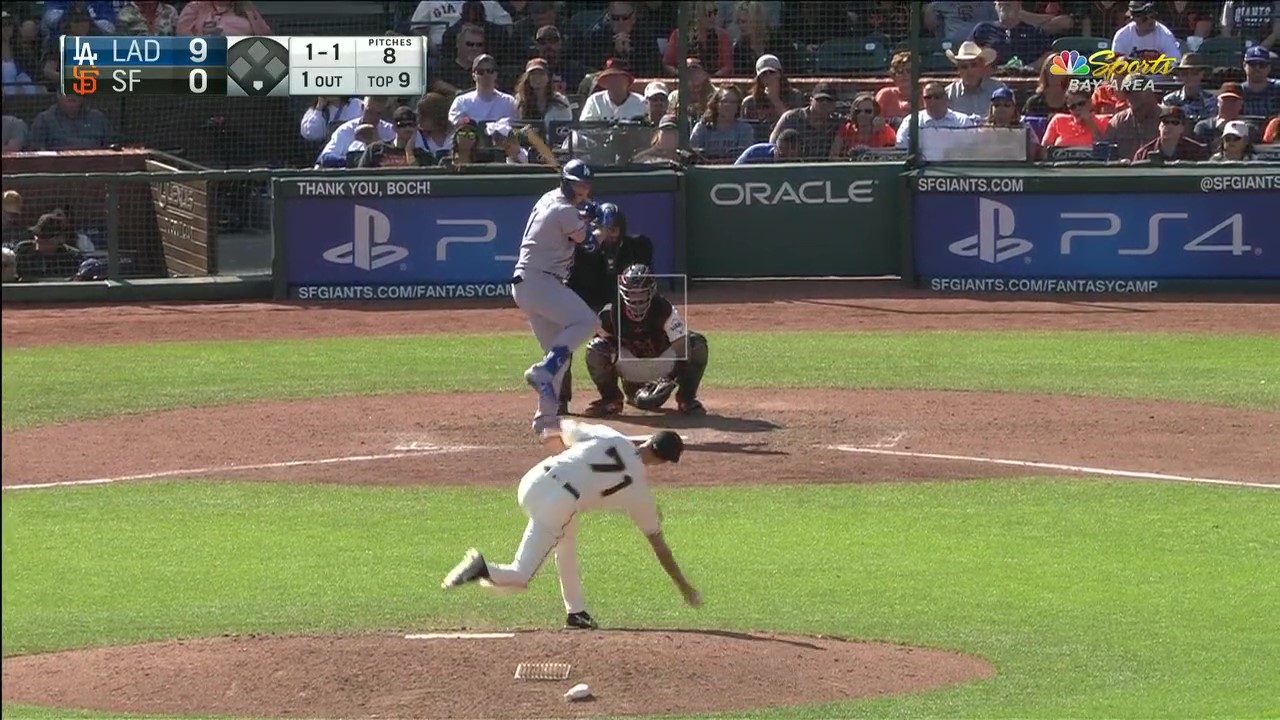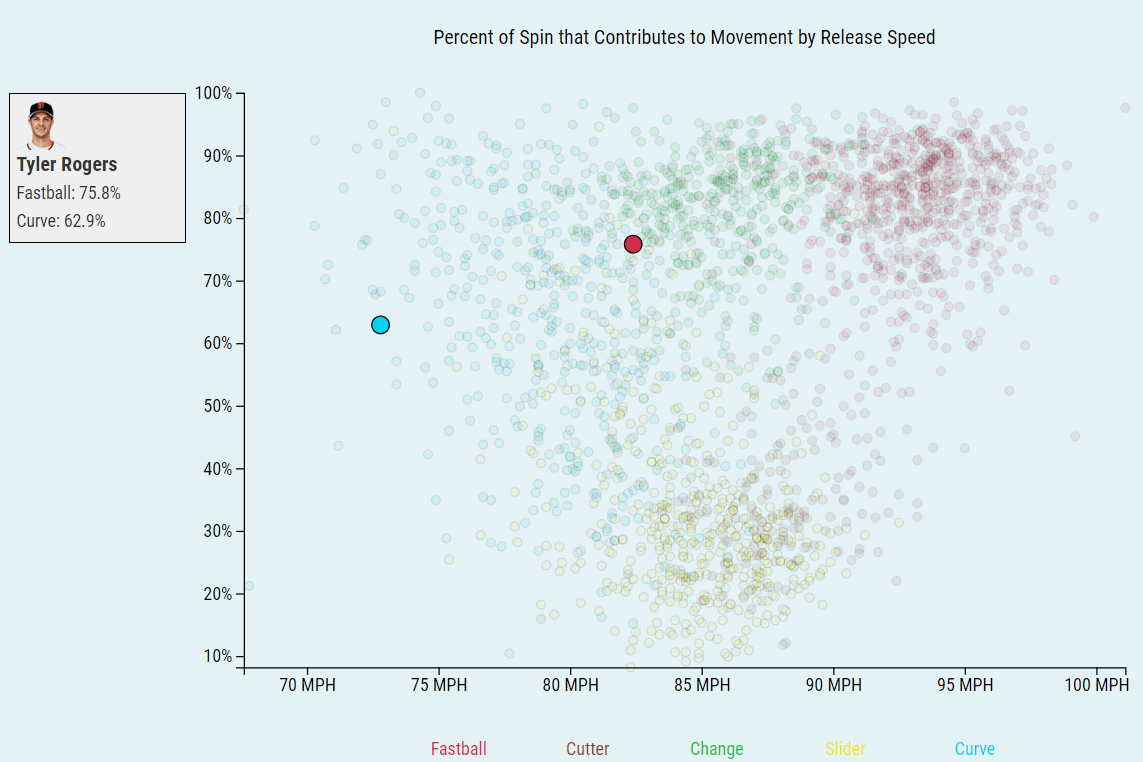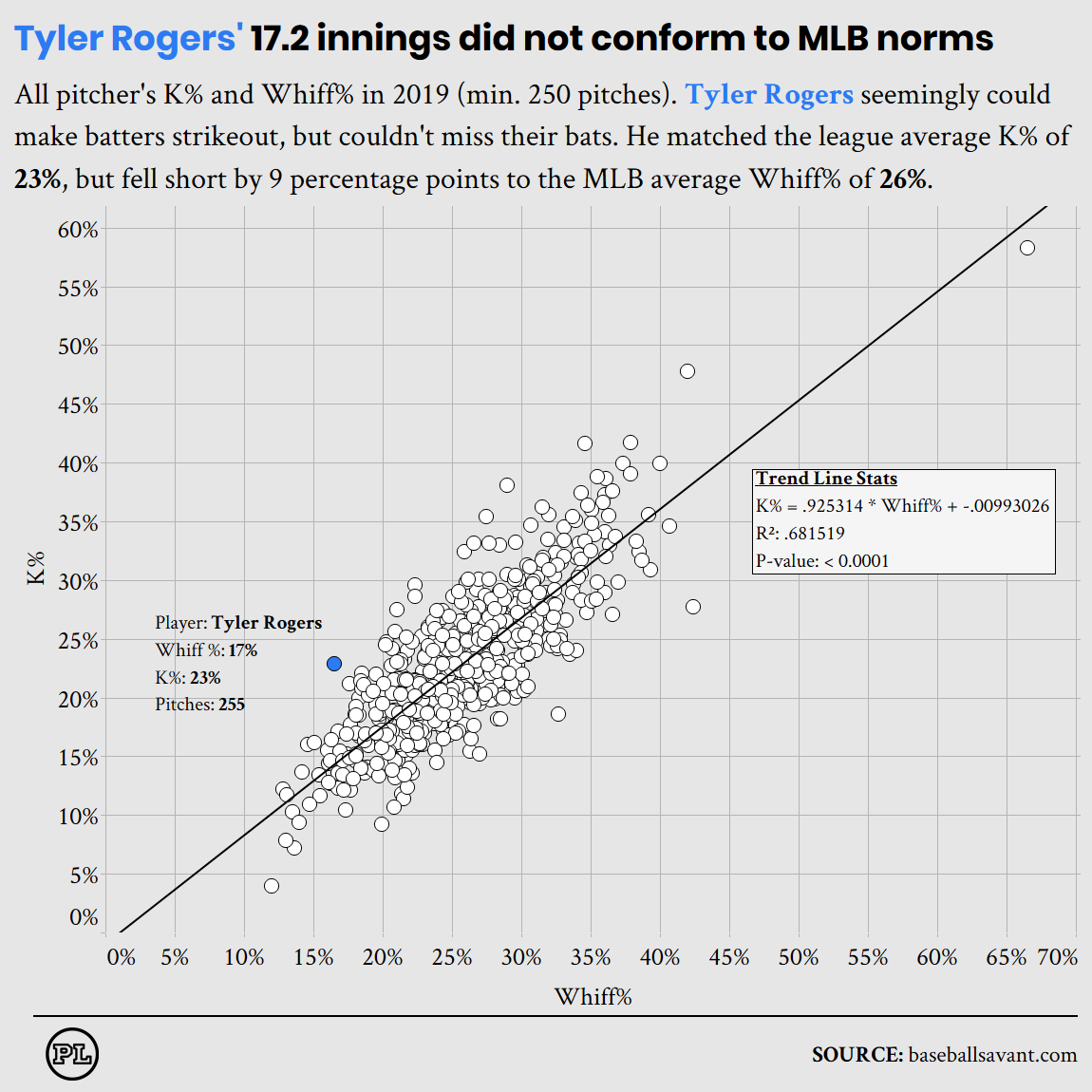Nowadays, there isn’t much to be excited about as a Giants fan. They have some intriguing prospects atop their farm system that should arrive in the big leagues in the coming years — and I just wrote about how I like Tyler Beede — but until then, it seems they’re focused on monopolizing the market on players who (a) are older than 32 years old and (b) whose best days are far behind them, in the even years of the early 2010s. As is, they’re pretty barren in the talent department in the major leagues. They’re not devoid of fun, though, as they have a quirky pitcher in Tyler Rogers.
That’s not a typo — Rogers is the twin brother of Twins pitcher Taylor Rogers, who is quite good himself. It took him a while, but at the age of 29, he might be kicking his career into gear. Let’s get some video out of the way.
Here’s Rogers throwing a sinker to Joc Pederson:
https://gfycat.com/grouchyoddgopher
An 83 mph sinker — middle-middle in a 1-1 count — taken for a strike. Quite strange! What’s particularly interesting to me, though, is that Rogers drops down awfully low in his delivery. It’s pretty cool, and you don’t see many pitchers do it nowadays. I hadn’t actually known much about Rogers before this week, and I hadn’t seen him pitch before, either. Our own Kyle Horton is the one who alerted me of Rogers’ submarining shenanigans. Here’s Kyle in action:

You can see why Kyle finds him interesting. For both Kyle and Rogers, the easy comparison is probably former Athletics reliever Chad Bradford.
Here’s a grainy picture of Bradford pitching in 2002:

And, here, a screengrab of Rogers from the video above:

You can see they both drop down incredibly low. When we last saw Bradford, his vertical release point was 1.06 feet, while Rogers was measured at 1.03 feet this year. The difference is negligible due to our margin of error for measuring release point, so this isn’t unprecedented in the literal sense, but it’s awfully rare. Of a 1,367 pitcher sample, Rogers has the lowest release point of the Statcast era, besting Kazuhisa Makita by just less than five inches.
We know his pitches are unique to an extent, but let’s take a look at just how unique they are, by horizontal and vertical movement. The circles are his pitches, while the dashed circles are league average:

As you can see, his slider (the blue dot) is, more or less, in order. It’s slower than league average, and has less vertical movement than is typical, but above-average horizontal movement. It’s a weird pitch! As for his sinker (orange dot), it’s quite possibly the weirdest pitch in the league. The average sinker is 93 mph with 14 inches of arm-side movement and 22 inches of drop (accounting for gravity). Rogers’ sinker, on the other hand, has just one and a half inches of arm-side movement, with 55 inches of vertical movement (with gravity).
So that’s one way to look at it. Here’s how Rogers’ pitches measure up with his peers’ pitches, plotted by active spin percentage and release speed, from Baseball Savant:

His sinker (red dot) is so slow it looks an awful lot like a changeup, while his slider is essentially a curveball (blue dot) when you look at it this way. Speaking of his slider, I presume you haven’t seen it yet. I’ll show you what it looks like, because it’s weird (of course) but also good!
Here’s Rogers, striking out Nolan Arenado on an 0-2 slider:
https://gfycat.com/femalebeneficialdeer
And striking out Neil Walker on a pitch that hits him:
https://gfycat.com/loathsomecompetentdipper
And here’s Rogers afterwards, trying his darnedest to suppress a smirk:

With a 35.9% outside-zone swing percentage, 53.6% zone percentage, and 19.1% swinging-strike percentage, Rogers’ slider is quite a strong pitch. Visually, it just seems to float through space, and it gives the perception of rise to hitters because, by spin axis, it’s no different from a four-seam fastball thrown out of a more conventional arm slot. The problem is that he throws it about half as often as his sinker, which has just a 2.9% swinging-strike percentage and 94.2% contact percentage. If you’re unfamiliar with those numbers, I’ll just tell you they’re awful. In spite of this, he has managed to strike out hitters at a decent clip in the past two years.
Strikeout rate, by year and level:
- 2016, AAA: 15.0%
- 2017, AAA: 13.7%
- 2018, AAA: 22.0%
- 2019, AAA: 20.4%
- 2019, MLB: 22.9%
Slowly but surely, Rogers has been increasing his strikeout rate, and he’s peaked thus far against major league competition, too. With that, you’d expect a solid swinging-strike percentage, but it’s been pretty pitiful overall.
Swinging-strike percentage, by year and level:
- 2016, AAA: 8.4%
- 2017, AAA: 8.6%
- 2018, AAA: 10.3%
- 2019, AAA: 9.1%
- 2019, MLB: 8.2%
In 2019, the MLB average swinging-strike percentage was 11.2% — Rogers is well below that mark at every level. Despite this, he put up a league-average strikeout percentage in 2019, which is pretty interesting to me. This is probably why Alex Chamberlain’s beta Tableau has disparity in Rogers’ strikeout percentage (22.9%) and expected strikeout percentage (14.8%). As a rule of thumb, swinging-strike percentage times two (SwStr% * 2) is usually in the ballpark of strikeout percentage. For this reason, a 14.8-16.4% strikeout percentage appears to be more realistic than the 22.9% Rogers put up in 2019.
We can compare him to other pitchers too! Here, I’ve plotted Rogers with other pitchers, with strikeout percentage and swinging-strike percentage representing our axes:

Part of me can believe in his numbers. It makes sense that, because his sinker isn’t a strong strike-getter, he can have some issues getting to pitchers’ counts to employ his slider. When he does, though, he’s got a really good slider to finish hitters off. And of course, our sample is small. On the other hand, though, the R-squared here is .68, which means that swinging-strike percentage accounts for 68% of the variance of strikeout percentage (which is lower than I’d thought it would be). If he can’t induce whiffs, then it feels foolish to bet on him continuing to get strikeouts, regardless of our reasoning.
That ignores called strikes, though, which we at Pitcher List know better than to do. As you’d have it, Rogers ranks in the 93rd percentile in called strikes. Taking this into account, Rogers’ 28.1% CSW ranks in the 51st percentile. So while his CSW could lead us to believe that Rogers could sustain his strikeout percentage — CSW has a 71% correlation to strikeout percentage — called strikes only explain 6% of the variance in SIERA for relievers, while swinging strikes account for 35%. Called strikes are nice, but they’re much nicer when reinforced with swinging strikes, which Rogers is currently lacking.
Despite his significant over-performance in strikeout percentage, Chamberlain’s Tableau has his own version of xwOBA that takes into account horizontal spray direction, as well as expected strikeout percentage and expected walk percentage. After putting up a .211 wOBA, Chamberlain’s version of xwOBA only has him regressing to a .224 xwOBA. So, he over-performed madly in strikeouts and walks, and yet he was basically still elite. What gives?
This one is easy. Rogers allowed incredibly weak contact, but it’s not at all sustainable in its current form. Allow me to show you why.
Rogers’ pitch type wOBAcon, versus league average:
- Rogers, sinker: .247
- League average, sinker: .373
- Rogers, slider: .158
- League average, slider: .371
Rogers’ pitch type xwOBAcon, versus league average:
- Rogers, sinker: .242
- League average, sinker: .370
- Rogers, slider: .114
- League average, slider: .356
Rogers’ pitch type BABIP, versus league average:
- Rogers, sinker: .257
- League average, sinker: .315
- Rogers, slider: .182
- League average, slider: .304
For league average sliders, it wasn’t clear whether I should treat Rogers’ slider as a curveball or slider. Because of its movement profile, speed, and active spin, I decided to use league average curveball numbers. In any case, I can believe in some over-performance, because Rogers is so, so incredibly weird. But this is far too extreme. Both of his pitches should regress pretty significantly — especially his slider.
Overall, Rogers was quite fortunate in his 17.2 inning cup of coffee. He over-performed by strikeouts, by walks, and allowed unsustainable weak batted ball quality. This all is pretty unlikely to persist, but at the same time, we’re talking about a pitcher with a 69.4% ground ball rate in a time where that’s incredibly valuable. He’s likely to come back to earth, but in a game of baseball that has evolved to fastballs exceeding 100 mph with an all-time high in dingers, there’s something romantic about Tyler Rogers overcoming the near-extinction of submariners and thriving thus far nonetheless.
Props to Kyle Horton for the article suggestion (@WhoHearsHorton on Twitter)
Graphic by Nick Kollauf (@Kollauf on Twitter)
Tyler Rogers photo by Keith Gillett/Icon Sportswire | Adapted by James Peterson (@jhp_design714 on Instagram and Twitter)


I imagine he will be a righty GB specialist.Everyone who throws from that arm slot throws a frisbee slider and gets GB. I also expect that lefties will crush him when he gets a few more IP That arms slot defines him and I think all submariners have those same tendencies. A strange guy like this makes pitch classification look bad. His stuff has nothing in common with most people’s SL and two seam FB, which is what he throws – yet he will serve as the outlier and figure into the mean – in other words its just noise. Brad Ziegler is what this looks like after a few hundred innings and his splits are really up and down. I imagine it is just generally effective v same-side hitters and a weird enough look to opposite handers that it can go either way. Being a GB specialist is very defense dependent which builds in a lot of noise to the results. For example, some double play balls are singles with empty bases. Ziegler retired a year ago so I am not sure how valued this skillset is… I wonder if it was more valued if he would still be player. Hard to say but he was kicking around for the Marlins at the end so I can see why he would retire lol. I am pretty sure that most teams would prefer a high velo sexy arm over one that helped them win. How many trams are even trying to win in 2020?